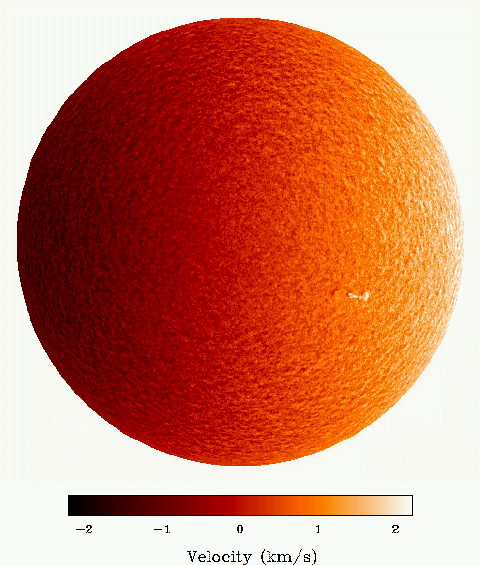|
dopplergram
Figure 1 Raw full-disc solar dopplergram from 9 July 1996, 09.00. Colormap shows line-of-site velocity with approximately 0.02 km/s uncertainty. Figure from the Solar Oscillations Investigation (SOI) website, http://soi.stanford.edu. |  |
![[*]](http://sepwww.stanford.edu/latex2html/cross_ref_motif.gif) shows a raw single full-disc
dopplergram. The colormap indicates line-of-site velocity. Both the
overall left-to-right trend (due to the sun's rotation), and the radial
pattern (an artifact of the line-of-sight measurement), are removed or
compensated for before the data is analyzed.
shows a raw single full-disc
dopplergram. The colormap indicates line-of-site velocity. Both the
overall left-to-right trend (due to the sun's rotation), and the radial
pattern (an artifact of the line-of-sight measurement), are removed or
compensated for before the data is analyzed.
|
dopplergram
Figure 1 Raw full-disc solar dopplergram from 9 July 1996, 09.00. Colormap shows line-of-site velocity with approximately 0.02 km/s uncertainty. Figure from the Solar Oscillations Investigation (SOI) website, http://soi.stanford.edu. |  |
Although it is difficult to see on a single image, the stochastic
nature of the solar oscillations is also apparent in
Figure ![[*]](http://sepwww.stanford.edu/latex2html/cross_ref_motif.gif) . Oscillations are continually
excited by turbulent convective cells within the solar
interior. Unlike most terrestrial seismologists who work with sources
that can be localized in time and space, helioseismologists have to
work with a stochastic source function, and oscillations that are
continually being excited.
. Oscillations are continually
excited by turbulent convective cells within the solar
interior. Unlike most terrestrial seismologists who work with sources
that can be localized in time and space, helioseismologists have to
work with a stochastic source function, and oscillations that are
continually being excited.
Helioseismologists often decompose the stochastic wavefields into spherical harmonics Gough and Toomre (1991); Harvey (1995); Kosovichev (1999). In the spherical harmonic domain, the chaotic nature of the source manifests itself in a random phase spectrum, whereas the deterministic solar structure manifests itself in the amplitude spectrum. The spherical harmonic amplitude spectrum, therefore, provides an excellent tool for studying the whole sun at one time. However, small-scale events are only described by harmonic modes of very high-order. Spherical harmonic functions are therefore inefficient for studying small, localized area's of the sun's surface.